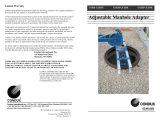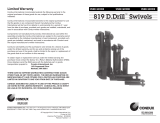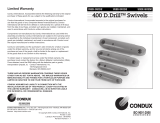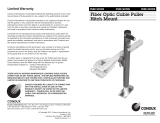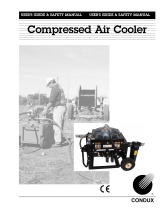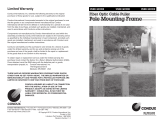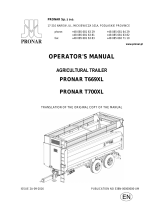Page is loading ...

Patent # 6264171
Gulfstream™400 with Electrical Counter
USER'S GUIDE & SAFETY MANUAL

2
Read and understand all procedures and safety instructions before using the Gulfstream™ 400. Observe all safety
information on this page and note specific safety requirements as explained by procedures in this manual.
Failure to follow these instructions could result in serious personal injury or death.
Important Safety Notice
ADVERTENCIA:
Favor de leer y comprender todas las instucciones de operación y seguridad antes de usar la máquina. Si
Ud. no comprende las instrucciones favor de consultarle a su jefe.
If you have questions on:
SAFETY - OPERATIONS - APPLICATIONS
CALL 1-800-533-2077
Save this user’s guide for future reference.
COMMUNICATIONS WITH THE MANUFACTURER
For any information related to the machine (use, maintenance, spare parts) always state Model, Serial
Number, Manufacturing Year and Order. This data can be found in the machine identification table.
Manufacturer:
Condux International Inc.
145 Kingswood Drive
Mankato, MN 56002-0247
1-507-387-6576
Fax 1-507-387-1442
Internet: http://www.condux.com
E-mail: [email protected]om

3
Table of Contents
1
2
5
6
7
9
8
General Information ...................................................................................................4
Technical Specifications ................................................................................................6
A. Hydraulic. . . . . . . . . . . . . . . . . . . . . . . . . . . . . . . . . . . . . . . . . . . . . . . . . . . . . . . . . . . . . . . . . . . . . . . . . . . . . . . . . . . . . . . . . . . . . . . . . . . .6
B. Condition of Use ............................................................................................6
C. Air Compression Requirements ..............................................................................6
D. Operational Capacities ......................................................................................8
E. Electronic Control Box .......................................................................................8
F. Physical Specifications .......................................................................................8
G. Acoustic Emission ...........................................................................................8
H. Caterpillar Drive Specifications. . . . . . . . . . . . . . . . . . . . . . . . . . . . . . . . . . . . . . . . . . . . . . . . . . . . . . . . . . . . . . . . . . . . . . . . . . . . . . .8
I. Conduit Coupling Requirements ..............................................................................8
Safe Operating Procedures .............................................................................................9
A. Work Area Safety ............................................................................................9
B. Hydraulic Devices ...........................................................................................9
C. Pneumatic Devices ..........................................................................................9
D. Electric Devices ........................................................................................... 10
Unpacking the Gulfstream™400 ...................................................................................... 10
A. Blower Components ....................................................................................... 10
B. Tools and Materials ........................................................................................ 10
Set Up the Blower .................................................................................................... 11
A. Attach Blower to Job Box .................................................................................. 11
Cable Crash Test ..................................................................................................... 12
Pressure Test Conduit ................................................................................................ 17
Prepare Conduit for Cable ............................................................................................ 22
Prepare Cable ........................................................................................................ 25
Final Set-Up ......................................................................................................... 27
A. Final Inspection ........................................................................................... 28
Blower Operating Instructions ........................................................................................ 28
A. Observer at Exit Pit ........................................................................................ 28
B. Connect Hydraulic Systems ................................................................................ 28
C. Set up the Electronic Control Box .......................................................................... 29
D. Panel Layout .............................................................................................. 30
E. Traction Control ........................................................................................... 32
F. Operation ................................................................................................. 32
Tear Down Procedures ............................................................................................... 34
A. Remove Power from Unit .................................................................................. 34
B. Remove Cable from Blower ................................................................................ 35
C. Separate Unit from Conduit ................................................................................ 35
Maintenance ......................................................................................................... 36
A. Track Cleaning & Tightening ............................................................................... 36
B. Replacement of Drive Belt ................................................................................. 36
Troubleshooting Guide ............................................................................................... 38
Appendices .......................................................................................................... 39
A. Blower with Job Box ....................................................................................... 39
B. Upper Drive Shaft Replacement Kit. . . . . . . . . . . . . . . . . . . . . . . . . . . . . . . . . . . . . . . . . . . . . . . . . . . . . . . . . . . . . . . . . . . . . . . . . 40
C. Lower Drive Shaft Replacement Kit. . . . . . . . . . . . . . . . . . . . . . . . . . . . . . . . . . . . . . . . . . . . . . . . . . . . . . . . . . . . . . . . . . . . . . . . . 41
D. Hydraulic Motor Replacement Kit .......................................................................... 42
E. Idler Bracket Bushing & Idler Bracket Screw Replacement Kits ............................................... 43
F. Air Block Assembly Replacement Kits ....................................................................... 44
G. Counter Clamp Roller & Cable Guide Replacement Kits ..................................................... 46
H. Timing & Takeup Roller & Idler Roller Replacement Kits ..................................................... 47
I. Hydraulic Coupler (Male) Replacement Kit .................................................................. 48
J. Hydraulic Coupler (Female) Replacement Kit ................................................................ 49
K. Clamp Adjustment Replacement Kit. . . . . . . . . . . . . . . . . . . . . . . . . . . . . . . . . . . . . . . . . . . . . . . . . . . . . . . . . . . . . . . . . . . . . . . . 50
L. Lower Counter Roller Replacement Kit ..................................................................... 51
M. RH Cable Guide Roller Replacement Kit .................................................................... 52
N. LH Cable Guide Roller Replacement Kit .................................................................... 53
O. Counter Spring Replacement Kit ........................................................................... 54
P. Base Mount ............................................................................................... 55
Q. Pneumatic & Electrical Circuits ............................................................................. 56
R. Hydraulic Circuit ........................................................................................... 57
S. Hydraulic Flow Control Valve ............................................................................... 58
T. Possible Wear & Replacement Parts & Accessories ........................................................... 59
Warranty Information ................................................................................................ 67
3
4
10
11
12
13
15
14
16

4
General Information
The operating instructions contain a full description of the Gulfstream™400, which has been
designed for the purpose of feeding fiber optic cable through round conduits of
uniform cross section. The conduit must previously have been installed underground
or overhead to receive the fiber optic cable and must be of sufficient length on exit to
be received by the machine. The conduit must be made of material with sufficient
compression strength for it to be adequately sealed in the exit of a machine. The
conduit must be airtight up to a pressure of 175 psi (12 bar). For this purpose,
connectors of screw, compression or fusion type must be used. Conduits from
(10 mm) to 1.97" (50.00 mm) and fiber optic cables from 1/4" (6 mm) to 1.13"
(28.7 mm) diameter can be accepted by the machine.
Fiber optic cable is fed into the conduit by combining pulling and pushing forces,
which draw the fiber optic cable through the conduit. The pulling force is achieved
by connecting the leading end of the fiber optic cable to a piston or carrier, which
fits exactly into the conduit to make an airtight seal. Air under pressure is fed in
behind the carrier causing it to be forced through the conduit. As the carrier moves
through the conduit, it pulls the fiber optic cable behind it. The fiber optic cable is
continuously pushed into the conduit by a tractor drive. This consists of two
caterpillar tracks, which grip the top and bottom of the fiber optic cable moving it into
the conduit. This ensures the fiber optic cable is always free as it moves into the
conduit and reduces the magnitude of the pulling forces needed to carry the leading
end through. Special lubricants are used to make it easier for the carrier to pass
through the conduit.
The exit of the machine consists of an air box that is made in two halves that clamp
together. The air box contains special removable seals on entry and exit, which
clamp around either the end of the conduit or the fiber optic cable to be fed into the
conduit. The seals can be changed to accommodate different conduit and fiber optic
cable sizes. The conduit is clamped between a pair of seals at the entrance to the
air block. A clamp located in front of the entrance to the air block holds the conduit
mechanically to prevent it from moving axially. The fiber optic cable enters through
two seals located in an aluminum nozzle that splits in half. The aluminum nozzle is
located in the entrance to the air box and is shaped to ensure an airtight seal around
the fiber optic cable. When the two halves of the air box are closed, air pressure is
admitted into the space between the seals on entry and exit.
The use of the Gulfsteam™400 for operations different from those discussed in this manual
are considered extremely dangerous and thus forbidden. The use of the Gulfstream™400
for purposes other than the one's described in this manual will result in improper use and
relieves the manufacturer from any responsibility, civil or penal. The manufacturer’s
responsibility declines even when one of the following happens:
a. The consequences caused by tampering and/or modifications carried out
without the manufacturer’s written acceptance.
b. The use of imitative spare parts.
c. Bad maintenance.
d. Use with disconnected safety devices.
e. The connection to machine and/or parts not produced and not directly
authorized by the manufacturer in a written acceptance.
1.

5
Designed to reduce stress on the fiber optic cable during installation The Gulfstream™ 400
is a unique device intended for inserting fiber optic cable directly into conduit with out the
use of pull tape and pulling machines.
Comprised of an air block and a tractor drive that, when combined with an air compressor
and a hydraulic power unit, will propel fiber optic cable measuring from 1⁄4" to 1.13" (6 mm
to 28.7 mm) into an unobstructed, unoccupied, airtight conduit run at speeds of 0 to 300
feet per minute (0-91 m/min). A cable carrier must be placed at the front end of the cable.
The Gulfstream™400 comes standard with job box, hydraulic hoses with couplings, digital
LCD electronic counter box, and an adjustable control valve to the tractor drive for speed
adjustment.
GENERAL MACHINE USE
a. Only qualified operators should use the machine. The operator should only be
the person who received qualified training from the product owning company or
trained by the manufacturer.
b. Machine must only be used for the work it was designed for.
c. Machine is not to be used with unauthorized personnel on the job site.
d. Should there be any doubt concerning use, functioning, maintenance or
anything else, please contact the factory or factory representative.
OPERATOR QUALIFICATIONS
a. Operator must know the required safety directives to run the machine that are
pertinent to the country where it is being used.
b. Operator in charge of the machine and installation project must be appropriately
dressed, avoiding large clothes, hanging jewelry or whatever might become
entangled in the moving parts.
c. Operator must also wear the necessary protective equipment such as gloves,
boots, helmet, etc.
d. Operator must carefully follow all advisements contained in the instruction
manual or on the machine.
e. Operator must have work area kept clean of obstacles that might inhibit a safe
working area.
MAINTENANCE QUALIFICATION
a. All of the machine maintenance must be carried out with the machine on a level
surface and not attached to any form of power source: electrical, pneumatic, nor
hydraulic.
b. Authorized and trained personnel must do all maintenance operations. Trained
personnel are defined as people who have received qualified training from the using
company or from the manufacturer.

6
Technical Information
A. HYDRAULIC SYSTEM REQUIREMENTS
• Hydraulic Operating Pressure: 1500 psi (103 bar) maximum
• Hydraulic Flow: 6.8 gpm (20.8 l/m) maximum
• Hydraulic Circuit Type: Open Center
• 5 micron filtration
• Fitted with BHTMA standard 1/2" flat faced quick release couplings
• Proper sized power unit should be used to run the blower machine to
prevent overheating
IMPORTANT: Operators must take any precautions that may have been
recommended by the suppliers of lubricants or hydraulic fluids. This applies to
the use and disposal of lubricants and hydraulic fluids including the
lubricant used to ease the passage of fiber optic cables through conduits.
B. CONDITION OF USE
Temperature from 21° F ( -6° C) to 110° F (+43° C)
Humidity from 30% to 90% +/- 5%
Weather conditions relevant to working conditions
Natural and/or artificial lighting of the work site, minimum 200 lux
C. AIR COMPRESSOR REQUIREMENTS
• Pneumatic Pressure: 175 psi (12 bar) Maximum
• Required Flow Capacity: 375 SCFM (11 m3/min) Maximum
• Conduit Size: 10 mm-1.97" (50 mm) OD
• Air coolers are recommended for blowing fiber
• Compressor flow may need to be doubled if blowing distance is greater than
3,500 feet (1,067 meters)
• Air hose fittings need to be compatible with Dixon “Air King” universal
couplings.
The following charts help to determine the compressor size requirement based on
testing the conduit system (Figures 1-3).
1. Pressurize the conduit up to the maximum compressor pressure. That is the
Pstart - value.
2. Time for 10 seconds and record the ending pressure, Pend.
3. Subtract Pstart-Pend and divide by 10.
4. Find the appropriate x value and approximate length of conduit run then correlate that
information with the size of the conduit on the graph. The resulting zone is the approxi-
mate compressor requirement.
D. OPERATIONAL CAPACITIES
2.

7
Figure 1. Compressor Sizing for 3,280 ft (1,000 m) of Conduit Run
Figure 2. Compressor Sizing for 4,921 ft (1,500 m) of Conduit Run
Figure 3. Compressor Sizing for 8,202 ft (2,500 m) of Conduit Run
OUT OF RANGE
OUT OF RANGE

8
• Pushing Force: 175 lbs (778 N) maximum
• Pushing Speed: 300 ft/min (91 m/min) maximum
• Cable Sizes: .25" to 1.13" (6 mm to 28.7 mm)
• Conduit Sizes: 1/2", 3/4", 1", 1-1/4" TRUE, 1-1/4", 1-1/2" SDR 11 & 13.5,
2" and metric O.D. conduit; 10 & 12 mm, 12.7 mm, 14 mm, 16 mm,
18 mm, 25 mm, 32 mm, 36 mm, 37 mm, 40 mm, 42 mm, 44 mm, 46 mm
and 50 mm
E. ELECTRONIC CONTROL BOX
• Power Requirements: 12 volts DC
• Power consumption is 24 Watts
• Power connection must be to automotive power point or power point
connection on Condux hydraulic power unit
• Fused with a 2.5 amp fuse, 250 volt-5x20mm-GMA type
• Displays: Total Machine Distance, Distance of Run, Operational Speed,
Errors Descriptions
• Automatic Shutdown Speeds: 300 ft/min (91 m/min) maximum
F. PHYSICAL SPECIFICATIONS DOES NOT INCLUDE LEGS OR JOB BOX
• Height 16.5" (419 mm)
• Length 30" (761 mm)
• Width 14.8" (375 mm)
• Weight 82 lbs (37 kg)
G. ACOUSTIC EMISSION
• Level of max. sound pressure to the operator seat (ISO 11202) Lep=85 dB(A)
H. CATERPILLAR DRIVE SPECIFICATIONS
• Maximum pushing force: 175 lbs (778 N), depending on cable diameter
• Maximum pushing speed: 300 ft/min (91.5 m/min)
• Maximum clamping force: <114 lbf/in (20 N/mm)
• Independent pushing drive belts with polyurethane pads profiled for cable
0.23" (5.8 mm) to 1.13" (28.7 mm)
• Mechanical gas charged shock absorber clamp to prevent cable crush.
• Side guards.
I. CONDUIT COUPLING REQUIREMENTS
• Must withstand maximum air pressure of 175 psi (12 bar).
• Must withstand axial loading and vibration.
• Must be screw type, compression type, or fusion type.
• Sight Holes must be sealed.
• Must fit snugly.
• Conduit ends must be cut off squarely and deburred.
• Conduit must be fully seated into the coupler.
• Couplers should be installed in a straight section of conduit.
• Must be same size as conduit.

9
Safe Operating Practices
Read and understand all procedures and safety instructions before using the Gulfstream™
400. Observe all safety information on this page and note specific safety
requirements as explained by procedures called out in this manual. Failure to follow these
instructions could result in serious personal injury, property damage or death.
A. WORK AREA SAFETY
1. Wear personal protective equipment: hard hat, safety glasses, safety shoes, and
leather work gloves.
2. The safe operation of this equipment requires that the operators be on
stable footing.
3. Stay clear of cables or lines under tension.
4. Stay clear of pressurized line and conduit.
5. Stay out of manhole while blower is in use.
6. Use the blower only for its intended purpose. Do not use the tractor drive
without the air block to push or pull cable.
7. Do not place cable reel too close to unit. Place the reel far enough away from
the unit to ensure proper control.
8. Do not tamper with relief valves or pressure reducing valves.
9. Place cable grip on end of conduit to catch cable carrier and cable.
10. Keep hands away from tractor drive while blower is in operation.
B. HYDRAULIC DEVICES
Escaping fluids under pressure can penetrate the skin and cause serious personal
injury. Observe the following precautions to avoid hydraulic hazards:
1. Tighten all connections before applying pressure. Relieve pressure when
connecting or disconnecting hoses when servicing the unit.
2. Check for leaks with a piece of cardboard. Do not use your hands!
3. Do not exceed working pressure of hydraulic hoses.
4. Visually inspect hoses regularly and replace if damaged.
C. PNEUMATIC DEVICES
The Gulfstream™ 400 is a pneumatic device, using pressurized air to project cable at high
velocities. Please observe the following precautions when operating the blower:
1. Forced air creates flying debris. Always wear personal protective equipment.
Severe personal injury could result.
2. Ensure no personnel are in the destination access vault during the blowing
operation. Severe personal injury could result.
3.

10
D. ELECTRIC DEVICES
The electronic counter box and power supply are electrical devices. Electric shock hazards
exist that could result in severe personal injury or death. Observe the
following precautions to avoid electrical hazards:
1. Do not operate in or near water. This includes setting the electronic counter box or
battery pack on a wet surface or exposing them to rain.
2. Do not remove cover of electronic counter box. There are no user-serviceable
parts inside. Refer servicing to qualified service personnel.
3. The electronic counter box power switch should be in the off position before
connecting or disconnecting any cords.

11
4.
Unpacking the Blower
A. BLOWER COMPONENTS
Each Gulfstream™ 400 Package contains the following items.
• Hydraulic hose from hydraulic control assembly to hydraulic power unit
• Owner’s Manual
• Shipping Crate
• Metric & Standard Allen Wrench Set
•
3⁄8" Drive Ratchet & 9⁄16" Deep Well Socket
•
5⁄8" x 600 lb. Swivel
• Venturi Air Plug
• Plastic Divided Case w/Parts Label
• Parts and User Manual
• 1 Qt. Blowing Lubricant
• Capscrew Set (10) (M04-0.7’s)
• O-Ring Seal Kit
NOTE: If any parts are missing: please contact your Condux representative or call Condux
International at 1-800-533-2077 (USA or CANADA), or 1-507-387-6576.
B. TOOLS AND MATERIALS REQUIRED
The tools and materials are necessary to connect the Gulfstream™ 400 to a hydraulic power
source, and to change the inserts:
1. Allen Wrench (3⁄32")
2. Allen Wrench (2.5 mm)
3. Allen Wrench (5 mm)
4. Screwdriver, Flat
5. Screwdriver, Phillips
6.
3⁄8" Drive Ratchet
7.
9⁄16" Deep Well Socket

12 12
Set Up the Blower
This manual contains setup and operating instructions for the Gulfstream™400 with
job box.
IMPORTANT: The Deluxe Blower must not be located below overhead gantries, power lines
or walkways where there might be a risk of falling objects. The operator must be wearing
recommended protective gear before operating the blower. Operating light levels should
be at least 200 lux of light intensity.
A. ATTACH BLOWER TO JOB BOX
CAUTION: The machine should be removed with two people or lifted mechanically
by the lift rings located on the top of the machine (Figure 4).
IMPORTANT: The Gulfstream™400 should not be parked on a slope in excess of 13°. It
should not be parked on a side hill of more that 15°.
Remove the ball detent pin from the bottom of the blower. Attach the Gulfstream™400 to
the job box by aligning the guide tracks on the bottom of the blower with the
channel on the top of the box. Holes in the box channel need to align with holes on the
blower guide track. Once aligned, replace ball detent pin so it locks the blower in place
(Figure 5).
Lift
Rings
Figure 4. Lift out Blower with
Lift Rings
Figure 5. Replace Ball Detent Pin
5.

1313
Cable Crash Test
Cable Crash Testing is a very quick and easy step to be completed before attempting the
installation of cable with the Gulfstream™400. This test is necessary to set the hydraulic
motor pressure of the blower below the point that it may cause cable
damage as a result of over pushing or encountering an obstruction in the
sub-duct system.
Every cable has different pushing values and these values vary depending on
duct I.D. Example: A cable with a crash test value of 75 bar in 33 mm I.D. duct,
may have a crash value of only 60 bar in a 40 mm I.D. duct. This is because the
area of lateral movement is larger as the duct size increases.
!CAUTION: Always wear protective equipment: hard hat, safety glasses,
safety shoes and work gloves.
NOTE: The hydraulic motor pressure adjustment will have no effect on the
installation speed of the blowing unit. This is not a flow adjustment. This is a
pressure adjustment to prevent damage to the cable that can be caused by excessive
pushing force.
IMPORTANT: For the Crash Test to work properly use the same size cable and duct
that will be used for the job.
Set the hydraulic motor pressure on your Gulfstream™400 using the following
procedure.
1. Attach 12' (4 m) of duct to the Gulfstream™400 (Figure 6).
2. Install Conduit Pulling Eye on the receiving end of the duct (Figure 7).
3. Cut a piece of fiber optic cable 15' (5 m)
long. This is your test piece of cable.
4. Attach the correct size Venturi to fit the cable being installed (Figure 8).
Figure 6. Placement of Conduit in
Conduit Seal & Conduit Clamp Figure 7. Installing Conduit
Pulling Eye
6.

14
5. Attach Hydraulic Hoses (Figure 9). The Gulfstream™400’s hydraulic system uses quick-dis-
connect couplings. Keep all connections clean to avoid contamination and possible sys-
tem failure. Use hose end caps (supplied). A contaminated hydraulic system will effect the
operation of the cable blower and may invalidate your product warranty. Take caution in
routing the hoses to prevent a tripping hazard. Follow these steps to connect the hydrau-
lic components:
A. Attach the quick-disconnectcouplings to the hydraulic powersupply (Figure 10).
B. Start the hydraulic power unit and check all connections for leaks with a piece of card-
board. In cold weather, run hydraulic power supply until hydraulic oil warms up.
WARNING: Escaping fluids under pressure can penetrate the skin and cause serious per-
sonal injury. Observe the following precautions to avoid hydraulic hazards:
• Tighten all connections before applying pressure. Relieve pressure before
connecting or disconnecting hoses.
• Check for leaks with a piece of cardboard. Do not use hands!
• Do not exceed working pressure of hydraulic hoses. Visually
inspect hoses regularly and replace if damaged.
C. Run the blower for approximately 1 minute to remove any trapped air and then stop
the blower and hydraulic power source.
14
OPERATOR
HYDRAULIC
POWER
SOURCE
INNERDUCT
AIR HOSE
FIBER
OPTIC CABLE
ELECTRICAL HOOK UP
TO POWER SOURCE
CABLE
REEL
HYDRAULIC
HOSES
DELUXE LW
BLOWER
AIR
COMPRESSOR
Figure 8. Install Venturi Figure 9. Typical Set-Up
Figure 10. Attach Hydraulic Hoses

15
ELECTRONIC CRASH TEST
To run the Crash Test utilizing the Electronic Control Boxes PRESSURE LIMIT feature,
follow Crash Test steps 1-5 to set up the blower.
6. Press Touch Screen “LIMIT: XXXX” to open the Limit keypad.
7. Enter the desired pressure – suggested starting point is 800 PSI.
8. Place Cable in Blower from Rear Rollers through Tractor Drive. Push cable through
the duct until it stops against the Pulling Eye (Figure 13).
9. Place a mark on the Cable about 2" (51 mm) behind the Rear Rollers (Figure 14).
10. Install top Venturi (Figure 15). Close Air Block and tighten (Figure 16).
11. From the Rear Rollers, pull out apprmately 8' (2.4 m) of cable from the blower.
12. To avoid start up pressure spikes, which will register on the pressure
transducer and produce a false pressure error, set the Hydraulic Flow Control to
the lowest speed by rotating the flow control knob clockwise until it stops.
15
Figure 13. Install Cable Figure 14. Mark the Cable
Figure 15. Install Top Venturi Figure 16. Close Air Block
and tighten

16
13. Lower the Tractor Drive Cover, and tighten until the tracks make contact with the
cable. Give one additional turn to the clamp screw.
14. Turn on Hydraulic Power, and press the ECB DRIVE button ON.
15. Increase speed as quickly as possible by turning the Hydraulic Flow Control coun-
ter-clockwise. The Cable should be pushed into the duct. Continue to speed up
the tracks until the cable stops and the ECB gives a HI-PRESSURE ERROR screen.
16. If a HI-PRESSURE ERROR appears, follow the on-screen instructions to reset the
electronics and return to the Operations screen.
17. Raise Tractor Drive Cover. Pull out 8' (2.4m) of cable from the blower.
18. Lower and tighten Tractor Drive Cover. Repeat steps 6-7 to increase the
pressure by 50 PSI.
19. Repeat steps 12-16 until cable damage is
seen – either in the form of jacket dam-
age or bends in the cable, the cable folds
over, or you reach 1500 psi. You will
notice cable fold-over because the line
drawn on the cable will
disappear inside the machine or duct.
(Figure 17).
20. Repeat steps 6 and 7 to reduce the
PRESSURE LIMIT by 50 PSI.
21. Remove folded fiber and test again at cur-
rent PRESSURE LIMIT settings to ensure
no fiber fold over or
damage occurs.
22. Remove test piece of fiber optic cable.
23. If the re-test is confirms no cable damage, Re-adjust Flow Control setting to the
slowest speed.
24. Remove test duct piece from the Deluxe Blower.
25. Crash test is complete.
16
Figure 17. Cable folds over

17
Pressure Test Conduit
The conduit system must be able to withstand a maximum pressure of 175 psi, and
be free of leaks. A Conduit Pressure Test Kit, part number 08761457, is available to
perform this test. Conduit may also be tested for pressure using the Gulfstream™400,
follow the steps below.
1. Loosen the 6 nuts on the Air Block assembly (Figure 20). Open the Conduit Clamp
Cover and Air Block Cover (Figure 21).
2. Select the correct Conduit and Cable Components according to conduit and cable
size. Refer to the Conduit and Cable Pack selection charts
(Tables 1 and 2, page 18).
3. Choose the correct Conduit Seal and install both halves securely. (Figure 22).
4. Choose the correct Conduit Clamp and install both halves (Figure 23).
Figure 20. Loosen Air
Block Assembly
Figure 21. Open Conduit Clamp
Cover & Air Block Cover
Figure 22. Install Conduit Seal Figure 23. Install Conduit Clamp
7.

18
Table 1. Cable Packs
Table 2. Conduit Packs
P/N Cable OD P/N Cable OD P/N Cable OD P/N Cable OD
Inch/mm Inch/mm Inch/mm Inch/mm
08780406 0.23-0.28 (5.8-7.2)
08780407 0.29-0.34 (7.3-8.8)
08761424 0.35-0.42 (8.9-10.7)
08761425 0.43-0.48 (10.8-12.2)
08761426 0.49-0.55 (12.3-14.0)
08761427 0.56-0.60 (14.1-15.2)
08761428 0.61-0.67 (15.3- 17.0)
08761429 0.68-0.73 (17.1-18.5)
08761430 0.74-0.79 (18.6-20.1)
08761431 0.80-0.85 (20.2-21.6)
08761432 0.86-0.92 (21.7-23.4)
08761433 0.93-0.97 (23.5-24.6)
08761434 0.98-1.04 (24.7-26.4)
08761435 1.05-1.13 (26.5-28.7)
08780395
PACKAGE
08643754
033-29-1194
08643755
033-29-1195
08643756
033-29-1196
08643757
033-29-1197
08781116
0.35-0.48 (8.9-12.2)
0.49-0.60 (12.3-15.2)
08780284 0.61-0.73 (15.3-18.5)
CABLE SEAL
CABLE GRIP
1
08781115
CABLE PACK
VENTURI
075-1.00 (19.1-25.4)
1.00-1.24 (25.4-31.5)
2
3
08780393
40.86-1.13 (21.7-28.7)08780396
0.35-0.60 (8.9-15.2)
0.61-0.85 (15.3-21.6)
08780285 0.74-0.85 (18.6-21.6)
0.23-0.34 (5.8-8.8) 08780281 0.23-0.34 (5.8-8.8)
08780394
0.21-0.35 (5.3-8.9)
0.32-0.48 (8.1-12.2)
0.42-0.61 (10.7-15.5)
0.53-0.74 (13.5-18.8)
0.64-0.87 (16.3-22.1)
08780286 0.86-0.97 (21.7-24.6)
08780446 0.98-1.13 (24.7-28.7)
08643758
033-29-1198
08643759
033-29-1199
08643137
033-03-013
P/N Duct Size P/N Duct OD P/N Duct OD P/N Carrier P/N Carrier OD P/N Duct OD P/N ID Range
Inch/mm Inch/mm Inch/mm Inch/mm Inch/mm Inch/mm Inch/mm
108780795
0.50"
SDR 11-13.5
08780791
0.84
(21.30)
08780786
0.84
(21.30)
08780793
0.688
(17.50)
08078300
0.75
(19.0)
08643131
033-03-012
.75-.99
(19-25)
08761840
.76-.87
(20-22)
208780680
0.75"
SDR 11-13.5
08780682
1.050
(26.6)
08780685
1.050
(26.6)
08780690
0.75
(19.0)
08078300
0.75
(19.0)
08643137
033-03-013
1.00-1.24
(25.4-31.5)
08761840
.71-.89
(16-22)
308780386
1.00"
SDR 11-13.5
08780369
1.315
(33.4)
08780307
1.315
(33.4)
08761250
1.121
(28.5)
08761439
1.25
(31.8)
08643149
033-03-016
1.00-1.24
(25.4-31.5)
08761842
1.06-1.43
(27-37)
408780392
1.25"
SDR 11-13.5
08780375
1.660
(42.2)
08780051
1.660
(42.2)
08761255
1.414
(35.9)
08761440
1.50
(38.1)
08643149
033-03-016
1.50-1.99
(38.1-50.5)
08761842
1.06-1.43
(27-37)
508780397
1.50"
SDR 11-13.5
08780404
1.900
(48.3)
08780398
1.900
(48.3)
08761260
1.618
(41.1)
08761441
1.75
(44.5)
08643149
033-03-016
1.50-1.99
(38.1-50.5)
08761844
1.37-1.68
(35-43)
608780930
2.00"
SDR 11-13.5
_____ _____ ______ ______ 08761265
2.023
(51.4)
08761442
2.00
(50.8)
08643155
033-03-017
2.00-2.49
(50.8-63.2)
08761846 2"
708781120 20mm 08781122
0.787
(20.0)
08781121
0.787
(20.0)
08780793
0.688
(17.5)
08761444
1.00
(25.4)
08643131
(033-03-012
.75-.99
(19.0-25.1)
08914007
.551-.813
(14-20.65)
808780240 25mm 08780099
0.984 (25.0
08780134
0.984
(25.0)
08780230
0.787
(20.0)
08761439
1.25
(31.8)
08643137
033-03-013
1.00-1.24
(25.4-31.5)
08761840
.71-.89
(18-22)
908780385 32mm 08780368
1.260
(32.0)
08761560
1.260
(32.0)
08761560
1.063
(27.0)
08761439
1.25
(31.8)
08643143
033-03-15
1.25-1.49
(31.8-37.8)
08761842
1.06-1.43
(27-37)
10 08780387 36mm 08780370 1.417
(36.0)
08761643
08761555
1.417
(36.0)
08761643
08761555
1.181
(30.0)
1.220
08761439 1.25
(31.8)
08643143
033-03-15
1.25-1.49
(31.8-37.8) 08761842
1.06-1.43
(27-37)
11 08780388 37mm 08780371
1.457
(37.0)
08761555
1.457
(37.0)
08761555
1.220
(31.0)
08761439
1.25
(31.8)
08643143
033-03-15
1.25-1.49
(31.8-37.8)
08761842
1.06-1.43
(27-37)
12 08780389 1.25" TRUE 08780372
1.500
(38.1)
08761670
1.500
(38.1)
08761670
1.250
(31.0)
08761440
1.50
(38.1)
08643143
033-03-15
1.25-1.49
(31.8-37.8)
08761842
1.06-1.43
(27-37)
13 08780390 40mm 08780373
1.575
(40.0)
08761579
1.575
(40.0)
08761579
1.299
(33.0)
08761440
1.50
(38.1)
08643149
033-03-016
1.50-1.99
(38.1-50.5)
08761842
1.06-1.43
(27-37)
14 08780391 42mm 08780374
1.653
(42.0)
08761660
1.653
(42.0)
08761660
1.378
(35.0)
08761440
1.50
(38.1)
08643149
033-03-016
1.50-1.99
(38.1-50.5)
08761842
1.06-1.43
(27-37)
15 08780545 44mm 08780546
1.732
(44.0)
08761786
1.732
(44.0)
08761786
1.496
(38.0)
08761440
1.50
(38.1)
08643149
033-03-016
1.50-1.99
(38.1-50.5)
08761842
1.06-1.43
(27-37)
16 08780575 50mm 08780435
1.969
(50.0)
08761579
1.969
(50.0)
08761579
1.606
(40.0)
08761442
2.00
(50.8)
08643149
033-03-016
1.50-1.99
(38.1-50.5)
08761844
1.37-1.68
(35-43)
INNERDUCT EYE
PACKAGE
DUCT PACK
DUCT CLAMP
DUCT SEAL
CARRIE
FOAM CARRIER
CABLE GRIP

19
5. Choose the correct Venturi to fit the cable being installed. Do not install at this time!
6. Place conduit in the Conduit Seal and Conduit Clamp. Note placement up to ridge
on Conduit Seal (Figure 24).
7. Clamp conduit in place (Figure 25).
8. Place Seal Disk in Venturi slot. (Figure 26).
9. Close Air Block Cover and secure (Figure 27). Tighten nuts securely, but do not over
tighten. Use a cross-tightening procedure.
Figure 24. Placement of Conduit
in Conduit Seal & Conduit Clamp
Figure 25. Clamp Conduit
in Place
Figure 26. Installing Seal Disk Figure 27. Tighten Air Block
Cover

20
10. Plug receiving end of Conduit with a properly sized Conduit Pulling Eye (Figure 28)
(Appendix R pg. 62).
11. Choose the correct Pulling Grip & install on receiving end of Conduit
(Figure 29).
12. Connect the Air Compressor (Figure 30).
a. Ensure Air Valve is off before connecting air hose.
b. Attach the hose supplied with the air compressor to the air compressor
coupling. The blower air valve assembly is equipped with a claw type
connector. Use safety clips on all pneumatic hose connections (Figure 31).
c. Observe all safety procedures.
d. Route all hoses properly to prevent tripping over them.
!WARNING: Forced air creates flying debris. Always wear personal
protective equipment. Severe personal injury could result.
!WARNING: Ensure no personnel are in the destination access vault dur-
ing the blowing operation. Severe personal injury could result.
Figure 28. Installing Conduit
Pulling Eye
Figure 29. Installing Pulling Grip
OPERATOR
HYDRAULIC
POWER
SOURCE
INNERDUCT
AIR HOSE
FIBER
OPTIC CABLE
ELECTRICAL HOOK UP
TO POWER SOURCE
CABLE
REEL
HYDRAULIC
HOSES
DELUXE LW
BLOWER
AIR
COMPRESSOR
Figure 30. Typical Connections Figure 31. Installing Air Hose with
Safety Clips
/

